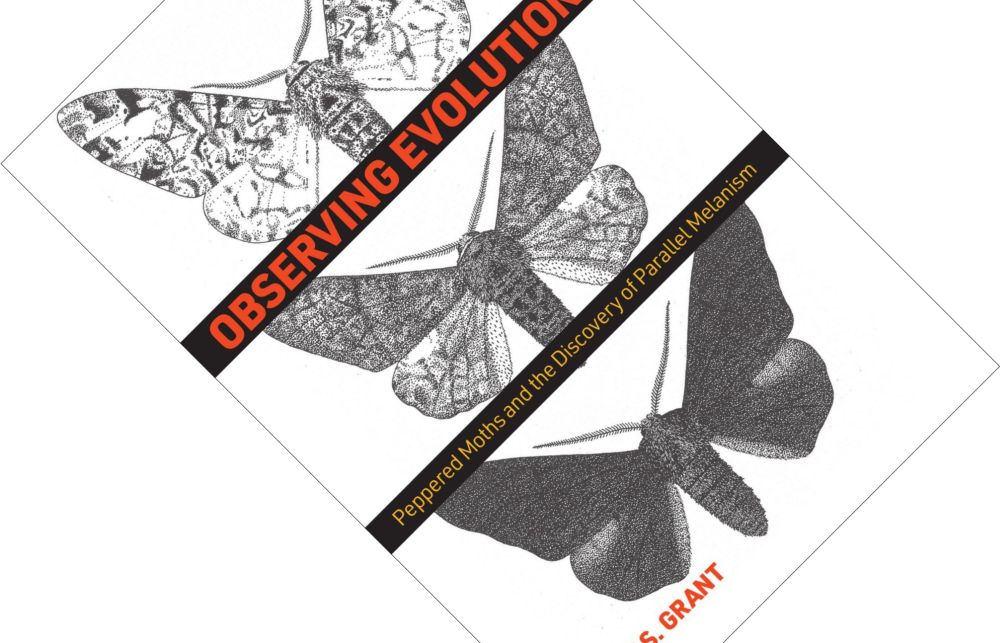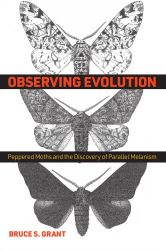7-minute read
keywords: evolutionary biology
Every student of evolution will be familiar with the peppered moth, Biston betularia. It is right up there with the Galápagos finches as an example of evolution happening right under our noses. The story of the rapid spread of dark moths in response to the soot deposition that accompanied the Industrial Revolution, and the reversal of this pattern when air pollution abated, is iconic. Yet, as Emeritus Professor of biology Bruce S. Grant shows, there are a lot more subtleties to it than my one-liner suggests. Observing Evolution details research by himself and many others, and along the way addresses criticism—legitimate and otherwise—levelled at some of the earlier research. Eminently readable, this is a personal story of the rise, fall, and ultimate redemption of one of the most famous textbook examples of evolution in action.

Observing Evolution: Peppered Moths and the Discovery of Parallel Melanism, written by Bruce S. Grant, published by Johns Hopkins University Press in October 2021 (hardback, 306 pages)
Melanins are a group of pigments found in cells of many vertebrates and invertebrates, some of them resulting in brown or black colouration. The appearance of dark insect morphs in response to pollution by heavy industry has been dubbed industrial melanism and occurs in many species. Grant opens his book by introducing two major players in this story: J.W. Tutt, who in 1896 first explained industrial melanism in peppered moths as resulting from visual predation by birds, and Bernard Kettlewell, who became the most important worker on this from the 1950s onwards to his death in 1979. As Grant clarifies, “while [Kettlewell] did not establish the concept of industrial melanism, he certainly resurrected it” (p. 10). Grant turned his attention to this species in 1983, at that point already head-long into an academic career on genetics and evolution using both fruit flies and wasps as model systems.
The author has divided his narrative over 49 short chapters, rarely more than ten pages long, which benefits the readability tremendously. Observing Evolution is informal in tone, full of friendly wit aimed at co-workers, and richly laced with anecdotes and personal stories. Grant for instance describes his experiences as an American working in 1984 England, joining a Liverpudlian bagpipe band. The description of his 1988 research trip to Japan sprawls over 70 pages and feels somewhat like a diversion that could have been shortened, especially as it boils down to “I was looking for moths in all the wrong places at all the wrong times”. Overall, though, his personal reflections on the hard work in the laboratory and the field, normally hidden behind the data, were very recognisable and relatable. They brought back happy memories of my research on butterflies in Paul Brakefield’s group and my later fieldwork at Tvärminne Zoological Station in Finland.
“Most spectacular is Grant’s work with Denis Owen that showed the rise and fall of melanism on both sides of the Atlantic in lockstep with air quality […]”
For biologists, Grant’s accessible explanations are a superb example of science communication. Let me highlight three of the many fascinating findings discussed here. Kettlewell published results showing that light and dark morphs rest on backgrounds matching their colouration, something that neither Grant nor others have been able to replicate. Individual moths seemed to have a preference, for sure, but it was not related to their colour. Grant also examined the genetic basis behind melanism in both British and Canadian populations. Kettlewell argued for the co-selection of certain genetic modifiers promoting the expression of melanism, and, by crossing individuals from different populations where melanism was or was not present, claimed melanism broke down in the hybrids. Grant and others have attempted similar experiments, criticising his work, though these all had their own shortcomings. Most spectacular is Grant’s work with Denis Owen that showed the rise and fall of melanism on both sides of the Atlantic in lockstep with air quality as measured by sulfur dioxide concentrations (though Grant hastens to add this link is correlative, not causative). Throughout, he delivers valuable commentary on how science proceeds and is never shy to admit his own mistakes.
You will notice that the name of Kettlewell frequently comes up in the context of research that could not be replicated and this lies at the heart of the controversy around the peppered moth. This is where Observing Evolution in my opinion unfortunately falls short of realising its full potential as the definitive story on the peppered moth, even if the ingredients are all there.
First, Judith Hooper accused Kettlewell of fraud in her 2002 book Of Moths and Men, with other researchers supposedly conspiring to cover this up. Now, there is legitimate criticism to be had of Kettlewell’s research, and Grant does not hold back in doing so. For example, he points out how Kettlewell never actually confirmed his idea that moths actively select a matching background to rest on: “it was pure speculation on his part, which was promoted—without supporting evidence—by his globally influential sponsor, E.B. Ford, and consequently assimilated into the lore and literature by uncritical enthusiasts” (p. 83). Grant has worked closely with people who knew Kettlewell personally and acknowledges that all of them “regarded him as a forceful personality, full of himself and his opinions” (p. 158). But he is sure Kettlewell was not a fraud: “he might arrive at wrong conclusions through stubbornness, but not by dishonesty” (p. 159). Yet, beyond briefly mentioning Hooper’s book in the beginning, Grant does not further touch on its publication, reception[1], and impact, even though it needlessly undermined a very well-supported model system.
“You will notice that the name of Kettlewell frequently comes up in the context of research that could not be replicated and this lies at the heart of the controversy around the peppered moth.”
Second, the flap text prominently mentions how “proponents of Creationism fomented doubts about the legitimacy of early experiments“—but you will have to wait for the epilogue to read about this[2]. Kettlewell also did experiments that showed that birds preyed on peppered moths and preferentially picked off individuals that stood out from their background, establishing them as the agent of natural selection driving industrial melanism. There is legitimate criticism to be had of these experiments, too, but the claim that birds do not eat moths is simply false and a prime example of the deliberate distortion of facts by creationists. Michael Majerus spend six years gathering the most comprehensive dataset on bird predation of peppered moths to date, though he passed away before he could publish it. Grant and three co-authors reanalyzed Majerus’s results and published them in 2012 . This is probably the most eye-catching aspect of the story—everybody wants to know who did it, after all—and is also the easiest to explain to a general audience. I was thus disappointed it is given such short shrift; its brevity contrasts painfully with the 70 pages lavished on the Japanese travelogue. Given Grant’s close involvement, I am sure that he could have written similarly lively chapters providing an insider’s perspective on this important facet of the peppered moth story.
. This is probably the most eye-catching aspect of the story—everybody wants to know who did it, after all—and is also the easiest to explain to a general audience. I was thus disappointed it is given such short shrift; its brevity contrasts painfully with the 70 pages lavished on the Japanese travelogue. Given Grant’s close involvement, I am sure that he could have written similarly lively chapters providing an insider’s perspective on this important facet of the peppered moth story.
Despite not quite hitting full marks for me, I do thoroughly recommend this book, both to evolutionary biologists and entomologists, and to a general audience only vaguely familiar with the peppered moth. Grant’s writing is accessible, his explanations of complex science easily digestible, and he is full of genuinely amusing stories. If you ever doubted the validity of this iconic example of rapid evolution, Observing Evolution will set you straight.
1. ↑ Though the mainstream press loved the book, several critical reviews were published by, amongst others, Jerry A. Coyne![]() , Kettlewell’s colleague Bryan Clarke
, Kettlewell’s colleague Bryan Clarke , historian of biology David Rudge
, historian of biology David Rudge![]() , and Grant himself
, and Grant himself![]() , though he does not mention the first three here.
, though he does not mention the first three here.
2. ↑ A good write-up of this particular chapter in history can also be found on 3 Quarks Daily.
Disclosure: The publisher provided a review copy of this book. The opinion expressed here is my own, however.
Other recommended books mentioned in this review:





3 comments